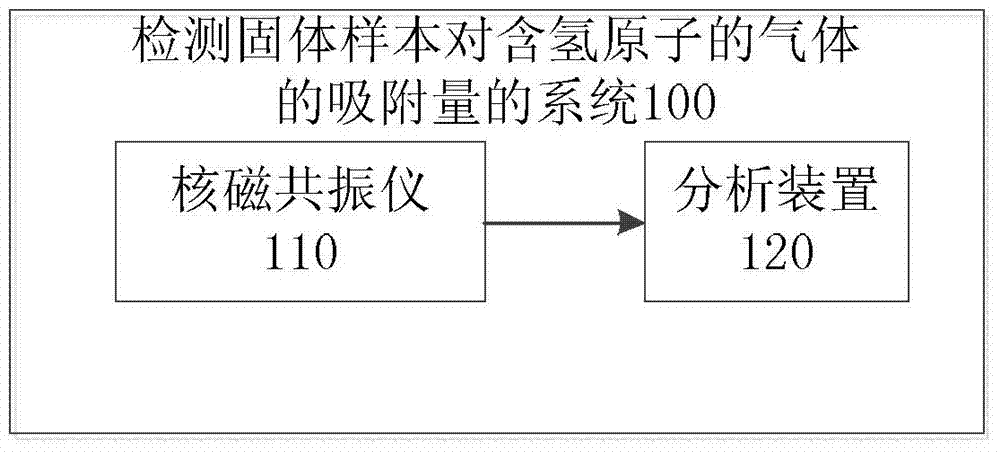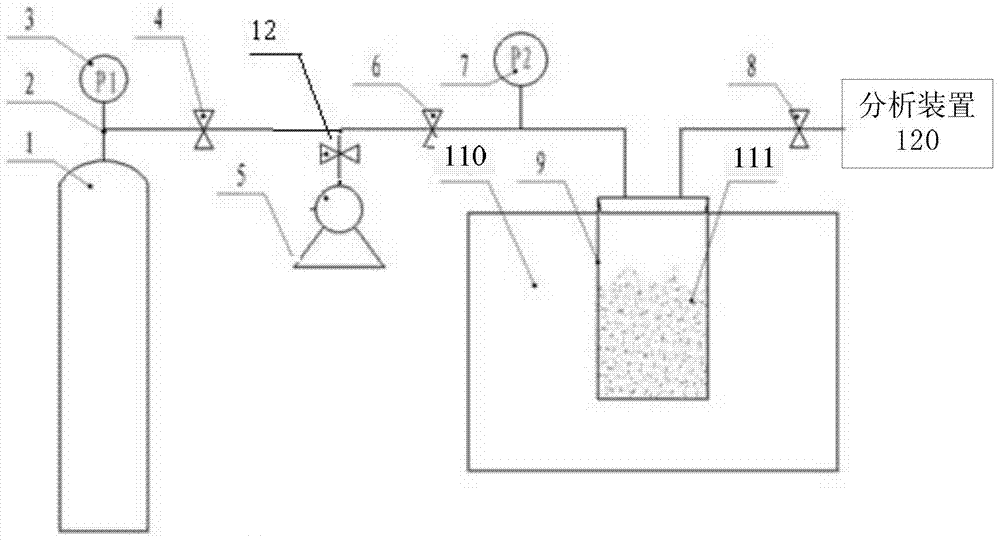Method and system for detecting adsorption capacity of solid sample to hydrogen-atom-containing gas
A technology of hydrogen atom and adsorption amount, which is applied in the direction of nuclear magnetic resonance analysis, etc., can solve the problems that the contribution of adsorption cannot be determined, the accuracy of measurement equipment is high, and there are many measurement equipment.
- Summary
- Abstract
- Description
- Claims
- Application Information
AI Technical Summary
Problems solved by technology
Method used
Image
Examples
Embodiment 1
[0071] Embodiment 1, the system that detects the adsorption capacity of solid sample to methane
[0072] image 3 A system for detecting the amount of methane adsorbed by a solid sample is shown. Such as image 3 As shown, the system includes a nuclear magnetic resonance instrument 110, and the nuclear magnetic resonance instrument 110 includes a sample bottle 111 for containing a solid sample (such as coal, shale, etc.) to be tested. The system also includes a cylinder 1 for containing methane gas. The gas cylinder 1 communicates with the sample bottle 111 and is used for inputting methane gas into the sample bottle 111 . The outlet of the gas cylinder 1 is provided with a first pressure gauge 3 for controlling the amount of methane gas input into the sample bottle 111 , that is, controlling the methane pressure in the sample bottle 111 . In addition, a first pressure gauge 7 may also be provided on the pipeline at the outlet of the sample bottle 111 for detecting the met...
Embodiment 2
[0072] image 3 A system for detecting the amount of methane adsorbed by a solid sample is shown. Such as image 3 As shown, the system includes a nuclear magnetic resonance instrument 110, and the nuclear magnetic resonance instrument 110 includes a sample bottle 111 for containing a solid sample (such as coal, shale, etc.) to be tested. The system also includes a cylinder 1 for containing methane gas. The gas cylinder 1 communicates with the sample bottle 111 and is used for inputting methane gas into the sample bottle 111 . The outlet of the gas cylinder 1 is provided with a first pressure gauge 3 for controlling the amount of methane gas input into the sample bottle 111 , that is, controlling the methane pressure in the sample bottle 111 . In addition, a first pressure gauge 7 may also be provided on the pipeline at the outlet of the sample bottle 111 for detecting the methane pressure in the first pressure gauge 7 to more accurately control the methane pressure in the ...
Embodiment 3
[0079] Embodiment 3, the method for detecting the porosity of solid sample
[0080] This embodiment uses the system described above, and specifically includes the following steps.
[0081] (1) Use the same steps as in Example 2 to determine the constant A i and the constant B i .
[0082] (2) Open the second valve 6 and vacuum the sample bottle 111 with the vacuum pump 5 . Put the coal sample to be tested in the sample bottle 111 . Close the second valve 6 and open the first valve 4, and inject methane gas at a pressure of 1Mpa into the sample bottle 111. The nuclear magnetic resonance instrument 110 collects the adsorption nuclear magnetic resonance signal in the sample bottle 111 , and sends the adsorption nuclear magnetic resonance signal to the analysis device 120 . Based on the nuclear magnetic resonance signal of the coal sample to be tested, the analysis device 120 determines the signal area S of the adsorption nuclear magnetic resonance signal of the coal sample t...
PUM
 Login to View More
Login to View More Abstract
Description
Claims
Application Information
 Login to View More
Login to View More - R&D
- Intellectual Property
- Life Sciences
- Materials
- Tech Scout
- Unparalleled Data Quality
- Higher Quality Content
- 60% Fewer Hallucinations
Browse by: Latest US Patents, China's latest patents, Technical Efficacy Thesaurus, Application Domain, Technology Topic, Popular Technical Reports.
© 2025 PatSnap. All rights reserved.Legal|Privacy policy|Modern Slavery Act Transparency Statement|Sitemap|About US| Contact US: help@patsnap.com



